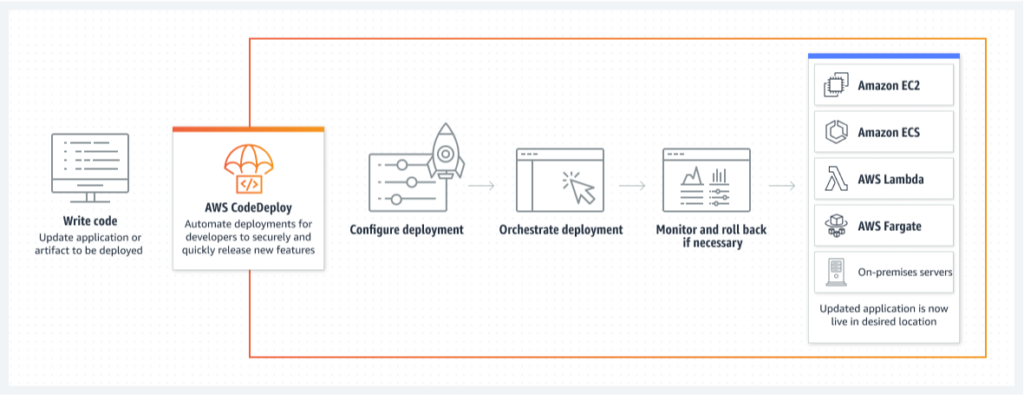What is AWS CodeDeploy?
AWS CodeDeploy is a deployment service that automates the deployment of software applications to various AWS platforms, including Amazon EC2 instances, AWS Lambda functions, and instances running on-premises. Its primary purpose is to facilitate consistent, rapid, and reliable software deployment processes. CodeDeploy allows developers and IT teams to deploy code with high availability and minimal downtime, which is crucial in continuous integration and continuous delivery (CI/CD) environments.

Source: AWS CodeDeploy
Core Features of AWS CodeDeploy
AWS CodeDeploy provides all the necessary features that developers require for deployment automation. Some of the features include:
- Automated Deployments: One of the key features of AWS CodeDeploy is its ability to automate the entire deployment process. This automation enables consistent and reliable deployments, reducing the manual effort and errors associated with traditional deployment methods. It supports a variety of deployment strategies, including in-place and blue/green deployments, allowing teams to choose the approach that best suits their operational model.
- Integration with Other AWS Services: CodeDeploy integrates seamlessly with other AWS services, enhancing its functionality and utility. For instance, it works with AWS CodePipeline for continuous delivery, AWS CodeCommit for source control, and AWS CodeBuild for compiling source code and running tests. This integration streamlines the deployment process and ensures that different stages of software release are well-coordinated and efficient.
- Scalability and Reliability: CodeDeploy is designed to scale with the needs of any application, whether deploying to a few instances or thousands. It ensures that the application is deployed incrementally across the fleet, thereby minimizing downtime and ensuring high availability. Its ability to handle a large number of deployments simultaneously makes it a reliable tool for both small-scale projects and large, enterprise-level operations.
- Security and Compliance Features: Security is a paramount concern in software deployment, and AWS CodeDeploy addresses this by providing powerful security features. It integrates with AWS IAM (Identity and Access Management), allowing users to set granular permissions for who can do what within the service. Moreover, it complies with various compliance standards, ensuring that deployments meet organizational and regulatory requirements.
Pricing offered by AWS CodeDeploy
AWS CodeDeploy offers a pricing model that is cost-effective and accessible for businesses of all sizes. One of the key aspects of its pricing is that there are no upfront fees or commitments required to use the service. Users pay only for what they use, based on the number of deployments and the compute resources used during the deployment process. Two of the critical pricing aspects of AWS CodeDeploy are:
- Deployments to AWS Services: Deployments to AWS services like Amazon EC2 instances, AWS Lambda, and AWS Fargate are typically included at no extra charge. This means that if you are deploying applications to these services, you will not incur additional costs from CodeDeploy itself.
- Deployments to On-Premises Servers: For deployments to on-premises servers, CodeDeploy charges a fee per instance update. This fee is calculated based on the number of on-premises instances a deployment targets each month.
Do I get any free tier for AWS CodeDeploy?
The pricing of AWS CodeDeploy is tied to the costs of other AWS components that you integrate with it, including EC2, Lambda, ECS, and on-premises instances. At the time of this article, AWS CodeDeploy does not provide a free tier option.
Cost Optimizations
Cost optimization is crucial for every AWS service. Here are some key strategies to consider when utilizing AWS CodeDeploy.
1. Efficient Resource Utilization
One of the key strategies for cost optimization in AWS CodeDeploy is the efficient utilization of resources. This involves carefully planning and executing deployments to ensure that resources are used optimally. For instance, choosing the right deployment strategy (in-place or blue/green) based on the application requirements and resource availability can significantly impact cost. Minimizing the use of unnecessary or underutilized resources during deployments can lead to substantial savings.
2. Leveraging Auto Scaling
Integrating CodeDeploy with AWS Auto Scaling can help ensure that you are only using (and paying for) the resources you need. Auto Scaling adjusts the number of instances automatically, based on the demand, which can be particularly cost-effective during off-peak times.
3. Using Spot Instances
For deployments that are not time-sensitive, using EC2 Spot Instances can lead to significant cost reductions. Spot Instances allow you to take advantage of unused EC2 capacity at a lower price than On-Demand Instances.
4. Optimizing Deployment Frequency
While continuous deployment is a key feature of AWS CodeDeploy, optimizing the frequency of deployments can result in cost savings. This involves balancing the need for frequent updates with the associated costs, potentially batching smaller updates together.
5. Monitoring and Analytics
Utilizing AWS CloudWatch and other monitoring tools to track deployments’ performance and cost implications can provide insights for cost optimization. This data can help identify inefficiencies and areas for cost reduction.
Conclusion
AWS CodeDeploy is a powerful tool in the AWS suite, for streamlined and efficient deployment automation. With careful planning, you can utilize AWS CodeDeploy while also keeping your budget cost-efficient.
Ready to elevate your AWS strategy?
[Reach out] for specialized guidance to ensure your setup is both cost-effective and high-performing.

